Enthronement 10 November 1915 Successor Showa | Predecessor Meiji Name Emperor Taisho | |
 | ||
Reign 30 July 1912 –25 December 1926 Prime Ministers See listKatsura TaroYamamoto GonbeeOkuma ShigenobuTerauchi MasatakeHara TakashiUchida Kosai (acting)Takahashi KorekiyoKato TomosaburoYamamoto GonbeeKiyoura KeigoKato TakaakiWakatsuki Reijiro Spouse Empress Teimei (m. 1900–1926) Children Hirohito, Takahito, Prince Mikasa, Yasuhito, Prince Chichibu, Nobuhito, Prince Takamatsu Parents Emperor Meiji, Empress Shoken, Yanagihara Naruko Grandchildren Akihito, Prince Tomohito of Mikasa Similar People Hirohito, Emperor Meiji, Empress Teimei, Takahito - Prince Mikasa, Yanagihara Naruko | ||
List of Emperors of Japan Meiji - Reiwa (from 1867)
Emperor Taishō (大正天皇, Taishō-tennō, 31 August 1879 – 25 December 1926) was the 123rd Emperor of Japan, according to the traditional order of succession, reigning from 30 July 1912 until his death in 1926.
Contents
- List of Emperors of Japan Meiji Reiwa from 1867
- Japan Emperor Hirohito visits the tomb of his father Emperor Taisho in Tokyo JHD Stock Footage
- Early life
- Education and training
- Marriage
- As emperor
- Great Kant earthquake of 1923
- Death
- Titles and styles
- National honours
- Foreign honours
- References
The Emperor's personal name was Yoshihito (嘉仁). According to Japanese custom, during the reign the emperor is called the (present) Emperor. After death he is known by a posthumous name that, according to a practice dating to 1912, is the name of the era coinciding with his reign. Having ruled during the Taishō period, he is posthumously known as "The Taishō Emperor" or simply "Emperor Taishō".
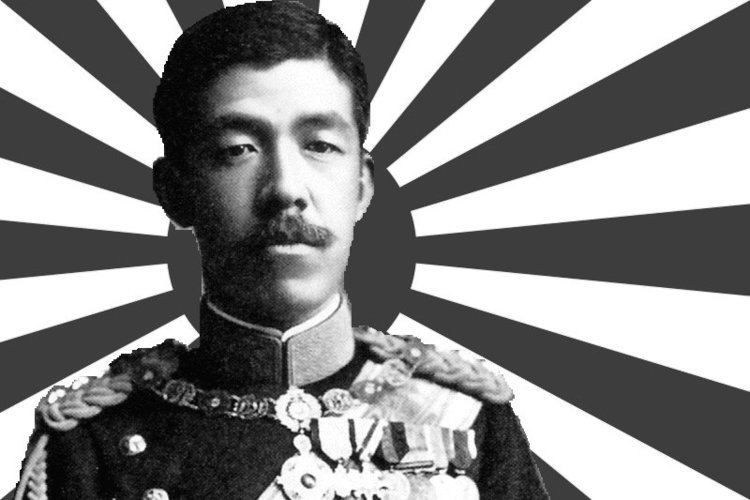
Japan Emperor Hirohito visits the tomb of his father, Emperor Taisho, in Tokyo, J...HD Stock Footage
Early life
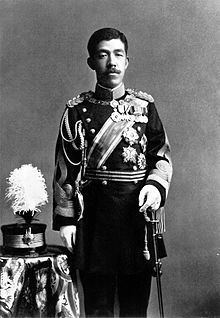
Prince Yoshihito was born at the Akasaka Palace in Tokyo to Emperor Meiji and Yanagihara Naruko, a concubine with the official title of gon-no-tenji ("lady of the bedchamber"). As was common practice at the time, Emperor Meiji's consort, Empress Shōken, was officially regarded as his mother. He received the personal name of Yoshihito Shinnō and the title Haru-no-miya from the emperor on 6 September 1879. His two older siblings had died in infancy, and he too was born sickly.
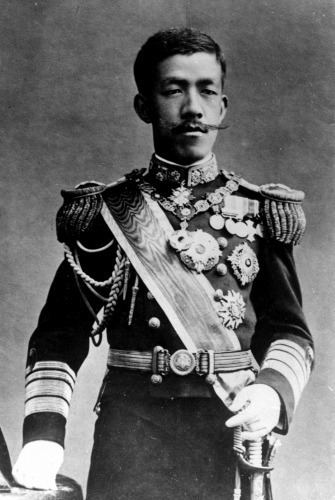
Prince Yoshihito contracted cerebral meningitis within three weeks of his birth, leaving him in poor health. (It has also been rumoured that he suffered from lead poisoning, supposedly contracted from the lead-based makeup his wet nurse used.)
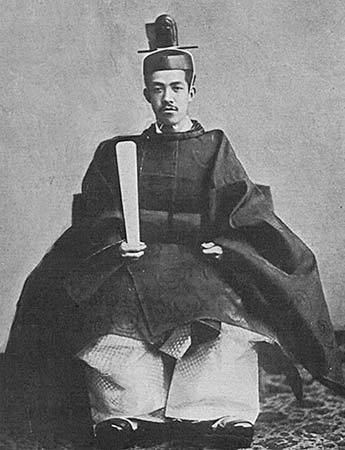
As was the practice at the time, Prince Yoshihito was entrusted to the care of Marquess Nakayama Tadayasu, in whose house he lived from infancy until the age of seven. Prince Nakayama had also raised Emperor Meiji as a child.
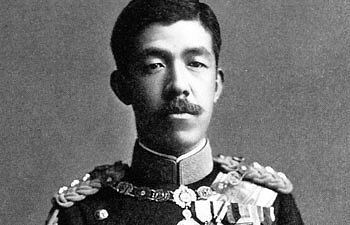
From March 1885, Prince Yoshihito moved to the Aoyama Detached Palace, where he was tutored in the mornings on reading, writing, arithmetic, and morals, and in the afternoons on sports, but progress was slow due to his poor health and frequent fevers. From 1886, he was taught together with 15–20 selected classmates from the ōke and higher ranking kazoku peerage at a special school, the Gogakumonsho, within the Aoyama Palace.
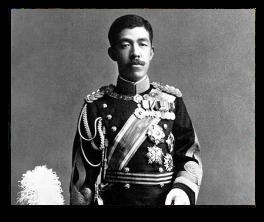
Yoshihito was officially declared heir on 31 August 1887, and had his formal investiture as crown prince on 3 November 1888. While crown prince, he was often referred to simply as Tōgu (東宮) (a long-used generic East Asian term meaning crown prince).
Education and training
In September 1887, Yoshihito entered the elementary department of the Gakushūin; but, due to his health problems, he was often unable to continue his studies. He spent much of his youth by the sea at the Imperial villas at Hayama and Numazu for health reasons. Although the prince showed skill in some areas, such as horse riding, he proved to be poor in areas requiring higher-level thought. He was finally withdrawn from Gakushuin before finishing the middle school course in 1894. However, he did appear to have an aptitude for languages and continued to receive extensive tutoring in French, Chinese, and history from private tutors at the Akasaka Palace; Emperor Meiji gave Prince Takehito responsibility for taking care of Prince Yoshihito, and the two princes became friends.

From 1898, largely at the insistence of Itō Hirobumi, the Prince began to attend sessions of the House of Peers of the Diet of Japan as a way of learning about the political and military concerns of the country. In the same year, he gave his first official receptions to foreign diplomats, with whom he was able to shake hands and converse graciously. His infatuation with western culture and tendency to sprinkle French words into his conversations was a source of irritation for Emperor Meiji.
In October 1898, the Prince also traveled from the Numazu Imperial Villa to Kobe, Hiroshima, and Etajima, visiting sites connected with the Imperial Japanese Navy. He made another tour in 1899 to Kyūshū, visiting government offices, schools and factories (such as Yawata Iron and Steel in Fukuoka and the Mitsubishi shipyards in Nagasaki).
Marriage
On 10 May 1900, Crown Prince Yoshihito married the then 15-year-old Kujō Sadako (the future Empress Teimei), daughter of Prince Kujō Michitaka, the head of the five senior branches of the Fujiwara clan. She had been carefully selected by Emperor Meiji for her intelligence, articulation, and pleasant disposition and dignity – to complement Prince Yoshihito in the areas where he was lacking. The Akasaka Palace was constructed from 1899 to 1909 in a lavish European rococo style, to serve as the Crown Prince's official residence. The Prince and Princess had the following children:
- Hirohito, Prince Michi (迪宮裕仁親王, Michi-no-miya Hirohito Shinnō, 29 April 1901 – 7 January 1989); the future Emperor Shōwa.
- Yasuhito, Prince Atsu (淳宮雍仁親王, Atsu-no-miya Yasuhito Shinnō, 26 May 1902 – 4 January 1953); later Prince Chichibu.
- Nobuhito, Prince Teru (光宮宣仁親王, Teru-no-miya Nobuhito Shinnō, 1 March 1905 – 3 February 1987); later Prince Takamatsu.
- Takahito, Prince Sumi (澄宮崇仁親王, Sumi-no-miya Takahito Shinnō, 2 December 1915 – 27 October 2016); later Prince Mikasa.
In 1902, Yoshihito continued his tours to observe the customs and geography of Japan, this time of central Honshū, where he visited the noted Buddhist temple of Zenkō-ji in Nagano. With tensions rising between Japan and Russia, Yoshihito was promoted in 1903 to the rank of colonel in the Imperial Japanese Army and captain in the Imperial Japanese Navy. His military duties were only ceremonial, but he traveled to inspect military facilities in Wakayama, Ehime, Kagawa and Okayama that year.
In October 1907, the Crown Prince toured Korea, accompanied by Admiral Tōgō Heihachirō, General Katsura Tarō, and Prince Arisugawa Taruhito. It was the first time an heir apparent to the throne had ever left Japan. During this period, he began studying the Korean language, although he never became proficient at it.
As emperor
On 30 July 1912, upon the death of his father, Emperor Meiji, Prince Yoshihito succeeded him on the throne. The new emperor was kept out of view of the public as much as possible. Having suffered from various neurological problems throughout his life, by the late 1910s, these maladies made it increasingly impossible for him to carry out public functions. On one of the rare occasions he was seen in public, the 1913 opening of the Diet of Japan, he is famously reported to have rolled his prepared speech into a cylinder and stared at the assembly through it, as if through a spyglass. Although rumors attributed this to poor mental condition, others, including those who knew him well, believed that he may have been checking to make sure the speech was rolled up properly, as his manual dexterity was also handicapped.
His lack of articulation and charisma (as opposed to Emperor Meiji), his disabilities and his eccentricities led to an increase in incidents of lèse majesté. As his condition deteriorated, he had less and less interest in daily political affairs, and the ability of the genrō, Keeper of the Privy Seal, and Imperial Household Minister to manipulate his decisions came to be a matter of common knowledge.
After 1918, he no longer was able to attend Army or Navy maneuvers, appear at the graduation ceremonies of the military academies, perform the annual Shinto ritual ceremonies, or even attend the official opening of sessions of the Diet of Japan.
After 1919, he undertook no official duties, and Crown Prince Hirohito was named prince regent (sesshō) on 25 November 1921.
Great Kantō earthquake of 1923
Taishō's reclusive life was unaffected by the Great Kantō Earthquake of 1923. Fortuitously, he had moved by royal train to his summer palace at Nikko the week before the disaster; but his son, Crown Prince Hirohito, remained at the Imperial Palace where he was at the heart of the event. Carrier pigeons kept the emperor informed as information about the extent of the devastation became known.
Death
In early December 1926, it was announced that the emperor had pneumonia. Taishō died of a heart attack at 1:25 a.m. in the early morning of 25 December 1926, at the Hayama Imperial Villa at Hayama, on Sagami Bay south of Tokyo (in Kanagawa Prefecture).
The funeral was held at night and consisted of a 4-mile-long procession in which 20,000 mourners followed a herd of sacred bulls and an ox-drawn cart containing the imperial coffin. The funeral route was lit with wood fires in iron lanterns. The emperor's coffin was then transported to his mausoleum in the western suburbs of Tokyo.
Taishō has been called the first Tokyo emperor because he was the first to live his entire life in or near Tokyo. Taishō's father was born and reared in Kyoto; and although he later lived and died in Tokyo, Meiji's mausoleum is located on the outskirts of Kyoto, near the tombs of his Imperial forebears; but Taishō's grave is in Tokyo, in the Musashi Imperial Graveyard in Hachiōji. His son, the Emperor Showa, is buried next to him.
